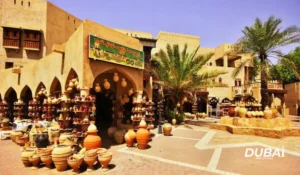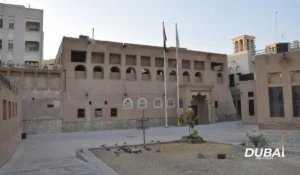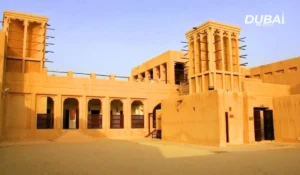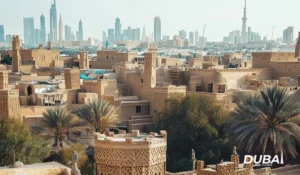Dubai is famous for its tall buildings and fancy life. But it was once a small fishing and trading village. Its heritage sites show its past, revealing the traditional culture that made it a global city.
Dubai has many ancient landmarks that show its importance. This article will show you the top 10 historical places in Dubai. They tell the story of Dubai’s growth.
These places include old souks and forts. They prove Dubai’s rich heritage and its mix of old and new. Visiting these sites helps you understand Dubai’s cultural evolution.
The Ancient Side of a Modern Metropolis

Dubai’s old side is hidden behind shiny skyscrapers. The city’s historical landmarks show its rich past. They mix old and new in a special way.
Dubai’s cultural tourism draws people from everywhere. They come to see its old sites. The city’s change from a small port to a big city is amazing. 15 Unique Reasons It Stands Out.
Dubai Before the Skyscrapers
Before oil, Dubai was simple. It was a trading port, with pearl diving and trade. The old souks and buildings remind us of this time.
The city’s early days are seen in places like the Al Fahidi Fort. And the Sheikh Saeed Al Maktoum House. They show Dubai’s past.
Why Historical Sites Matter in Dubai’s Story
Dubai’s historical landmarks in dubai are key to its story. They show how the city changed and grew. They tell us about its people and economy.
Keeping these sites helps Dubai’s dubai cultural tourism. It brings visitors who want to learn about Dubai’s history and culture.
Dubai Old Town: The Original Settlement

Dubai Old Town is by Dubai Creek. It takes you back to Dubai’s start. It was a key pearl diving port, starting Dubai’s growth.
Walking Through Dubai’s Beginnings
In Dubai Old Town, see the Bastakiya Quarter. It’s one of Dubai’s oldest spots. The narrow alleys and Arabic buildings show Dubai’s past.
The wind tower architecture is unique. It shows how clever Arabian builders were.
How to Spend a Day in Old Dubai
Here’s a plan for your visit:
Morning Exploration Route
Begin by checking out the Al Fahidi Historical Neighbourhood. See the Arabian houses and learn about Dubai’s history.
Afternoon Cultural Experiences
In the afternoon, go to the Dubai Museum. It teaches you about Dubai’s culture. Then, take a traditional abra ride on Dubai Creek. It’s a special way to see the city’s old trade paths.
| Attraction | Location | Best Time to Visit |
| Bastakiya Quarter | Al Fahidi, Bur Dubai | Morning |
| Dubai Museum | Al Fahidi Fort, Bur Dubai | Afternoon |
| Dubai Creek | Deira or Bur Dubai banks | Evening |
Al Fahidi Fort: Dubai’s Oldest Standing Structure

Al Fahidi Fort is Dubai’s oldest building. It has seen the city change a lot over time. Today, it’s part of the Dubai Museum and draws about 2000 visitors every day.
The Fort’s Evolution Through Centuries
Al Fahidi Fort was built in the late 18th century. It started as a defense against invaders. Later, it was a royal home and even a jail. The fort’s design shows its importance in history.
Architectural Highlights
The fort’s look is a mix of Arabic style and defense needs. Its strong walls and watchtowers helped keep the city safe.
What Makes Al Fahidi Historical Neighbourhood Worth Visiting
The area around the fort is full of history and culture. You can walk through old streets, see traditional houses, and visit museums. It’s a great way to learn about Dubai’s past.
Cultural Significance
Al Fahidi Fort and its area are more than just old buildings. They are cultural centers that keep Dubai’s traditions alive. They show how the city values its heritage even as it grows.
Jumeirah Mosque: Spiritual Heritage

The Jumeirah Mosque was a gift from the Late Sheikh Rashid bin Saeed Al Maktoum. It’s a beautiful example of Islamic architecture. This mosque is not just for worship but also a key cultural spot in Dubai.
Islamic Architecture and Design Elements
Jumeirah Mosque is famous for its mix of old and new designs. Its design follows Islamic rules, with detailed patterns and shapes. The minarets and the minbar make it stand out.
The mosque shows off the skill of the time, with beautiful stonework and calligraphy. It uses old materials and new ways to build, making it both historic and beautiful.
Visitor Experience and Cultural Programs
Visitors to Jumeirah Mosque get a special look into Islamic and Emirati cultures. They can take guided tours to learn about its history and architecture. These tours are great for those interested in Dubai cultural tourism and Emirati traditions.
Photography Opportunities
The mosque is perfect for photos, with its beautiful design and Dubai’s skyline. Visitors can take pictures of its details and the mosque itself.
Guided Tour Highlights
Guided tours of Jumeirah Mosque share lots of info about its history and culture. You can learn about its importance in Dubai’s culture. This helps visitors understand Islamic architecture better.
Old Souk: Traditional Arabian Marketplaces

Dubai’s Old Souk, also known as Bur Dubai Souk, is a lively place. It’s where old traditions meet new ways. This historic market is a top spot for anyone wanting to see real Arabian culture.
The Old Souk is known for its lively vibe. It has many small shops. They sell gold, spices, textiles, and souvenirs.
Gold and Spice Souks: Trading Traditions
The Old Souk has the famous Gold Souk and Spice Souk. Here, you can see old trading ways. The Gold Souk shines with gold jewelry and precious stones.
The Spice Souk is a treat for your senses. It’s filled with spices, herbs, and fragrances.
- Explore the narrow alleys and discover unique souvenirs.
- Experience the traditional Abra boat rides across Dubai Creek.
- Marvel at the intricate designs and craftsmanship on display.
Bargaining Tips for American Visitors
Bargaining is key in the Old Souk. For Americans, knowing local customs is important. Here are some tips to help you shop like a pro:
Must-Buy Authentic Souvenirs
Look for handmade crafts, local textiles, and traditional perfumes. These are unique souvenirs that show Dubai’s rich culture.
Navigating the Maze of Shops
To get good deals, be ready to bargain. Start with a lower price than you want to pay. Be ready to negotiate.
If you’re not happy with the price, walk away. This might make the vendor offer a better deal.
Dubai Museum: Journey Through Emirati History

The Dubai Museum is a must-see for anyone wanting to learn about Dubai’s past. It’s in the Al Fahidi Fort. Here, you can see how Dubai changed from a small fishing village to a big city.
The museum shows what life in pre-oil Dubai was like. You’ll see old clothes, jewelry, and home items. These things tell us about Dubai’s history and culture.
Life in Pre-Oil Dubai Exhibits
The life in pre-oil Dubai exhibits are very interesting. They show what daily life was like before oil was found. You can see models of old Arabian homes and markets.
These exhibits show how clever and strong the people of Dubai were back then. They give us a special look at the city’s history.
Interactive Displays and Historical Artifacts
The Dubai Museum also has interactive displays and many historical artifacts. These make the city’s history come alive. The maritime heritage exhibit is especially cool. It shows Dubai’s history as a trading port.
Maritime Heritage Section
The maritime heritage section is a big deal. It has traditional dhows and other items. These show Dubai’s important role in trading.
Desert Life Dioramas
The desert life dioramas are also very interesting. They show scenes of Bedouin life. This gives us a peek into the culture and traditions of the desert nomads.
Al Ahmadiya School: Educational Heritage

Dubai started its education journey with Al Ahmadiya School. It was the first national school in Dubai. This school was key in Dubai’s education and culture.
Dubai’s First Formal Educational Institution
Al Ahmadiya School opened in 1912. It was a big step for Dubai’s education. The school started with basic subjects like Arabic and math.
This school was more than just a school. It was a sign of Dubai moving towards modern times. It helped prepare many for the future.
Preservation Efforts and Restoration
Al Ahmadiya School has been fixed up many times. These fixes helped keep the school a big part of Dubai’s history. Now, people from all over come to see it.
Historical Teaching Methods
The school used new and old ways to teach. Some of these ways included:
- Traditional Islamic studies
- Basic arithmetic and calligraphy
- Oral recitation and memorization
Notable Alumni
Many famous people went to Al Ahmadiya School. They have helped Dubai grow. They are known in business, politics, and culture.
Souq Al Hadid Archaeology Museum: Ancient Discoveries

The Souq Al Hadid Archaeology Museum is in the Shindagha Heritage District. It shows Dubai’s rich history. The museum is in a historic building now filled with ancient finds.
It has many artifacts. These show how Dubai changed from a small port to a big city. You can see old coins, pottery, and more. They tell the story of Dubai’s past.
Archaeological Treasures and Their Significance
The museum has many treasures from Dubai’s old days. These include things from the Umm Al Nar period, about 2500 BCE.
These finds connect the old days to now. They give us a special look at Dubai’s culture and history.
What is the Oldest Historical Place in Dubai?
There’s a big debate about Dubai’s oldest place. Some say it’s Jumeirah from the 7th century CE. Others say Al Sufouh is important because of its old artifacts.
Dating Methods and Research
Archaeologists use special ways to find out when things were made. They use radiocarbon dating and stratigraphy.
Ongoing Excavations
There are still digs happening in Dubai. They find new things that tell us more about Dubai’s history and culture.
Hatta Heritage Village: Mountain Culture Preserved

Hatta Heritage Village is in the Hajar Mountains. It shows Dubai’s rich culture. Here, visitors can see how people lived in the mountains.
Life in Dubai’s Mountainous Regions
The village shows life in the mountains. It has traditional buildings and artifacts. These show how tough and clever the locals were.
People in the mountains lived together. They grew food, raised animals, and made crafts. Their homes show many cultures, like Arabic and African.
Traditional Buildings and Restoration
The village has many traditional buildings. These include houses and mosques from long ago. They have been fixed up to show their old beauty.
Restoring these buildings was a big job. They used old materials and ways to keep them real. You can see old watchtowers and enjoy the mountain views.
Seasonal Festivals and Events
The village has seasonal festivals all year. There’s music, dance, crafts, and more. These celebrate the area’s culture.
Surrounding Natural Attractions
The village is near breathtaking natural beauty. The Hajar Mountains are great for hiking. You can also see the Hatta Dam and enjoy the winter views.
Sheikh Saeed Al Maktoum House: Royal Heritage

Dubai’s rich history is in the Sheikh Saeed Al Maktoum House. It was a royal home that lasted a long time. It’s a key spot for those who love Dubai’s royal past and amazing buildings.
The Ruling Family’s Historical Residence
Sheikh Saeed Al Maktoum House was Sheikh Saeed bin Maktoum Al Maktoum’s home. It was where the ruling family lived for many years. The house shows the Al Maktoum family’s life and Dubai’s history. It’s a big cultural symbol, showing the Emirati people’s traditions and values.
Architectural Features and Historical Collections
The house’s design mixes Arabian and Islamic styles. It has cool barjeel wind-towers and restored rooms. Inside, you’ll find many historical items like photos, coins, and traditional things. They tell Dubai’s story of growth.
Photography Exhibition
The house has a photo show about Dubai’s history. These photos tell Dubai’s story from the start to now. It’s a visual journey of the city’s growth.
Views of Dubai Creek
Visiting Sheikh Saeed Al Maktoum House lets you see Dubai Creek. This waterway helped Dubai grow. It’s a big part of Dubai’s history and who it is today.
Burj Nahar: Defensive Watchtower

Burj Nahar was built in 1870. It is one of three water towers that watched for enemies around Deira city. This tower is a key part of Dubai’s history and shows its strategic role.
Military History and Strategic Importance
Burj Nahar was key in defending Dubai. It watched for threats from tribes. Its strategic location helped it see dangers early.
The tower’s design shows the military architecture of its time. It shows the city’s rulers were smart and forward-thinking.
Burj Nahar is more than a military site. It shows Dubai’s growth and how it changed over time.
Surrounding Gardens and Modern Context
Now, Burj Nahar is a famous spot for tourists. It has beautiful gardens around it. These gardens make a calm spot, unlike its past.
People love to see the nighttime illumination of the tower. It makes the tower look even more special.
Nighttime Illumination
The nighttime illumination of Burj Nahar is amazing. It lights up the tower, showing off its design.
Nearby Historical Sites
Burj Nahar is close to other important historical spots in Dubai. It’s a great place to start a tour of the city’s history. You can see other landmarks that add to Dubai’s rich history.
Complete Guide to Historical Places in Dubai for Visitors

Dubai has many sites for history lovers. You can see ancient forts, traditional souks, and museums. These places show how Dubai changed from a small port to a big city.
Best Time to Visit Dubai Creek for History Exploration
The best time to see Dubai Creek is from November to March. The weather is nice then. It’s perfect for walking tours and visiting places like the Al Fahidi Historical Neighbourhood and the Dubai Museum.
Visiting during the Dubai Shopping Festival or the Dubai International Film Festival is great too. These events have cultural programs and historical shows.
Are There Free Historical Places in Dubai?
Yes, Dubai has free historical places to visit. The Jumeirah Mosque has tours for a little cost. The Al Ahmadiya School and Sheikh Saeed Al Maktoum House have low entry fees.
Some museums and sites are free on certain days. Check their websites before you go.
Transportation Options Between Historical Sites
Dubai has many ways to get around. The Dubai Metro is cheap and easy. Many historical sites are near metro stations.
Also, try the abras (water taxis) on Dubai Creek. They give a special view of the city’s waterways. Taxis and ride-hailing services are also easy to find.
Bridging Past and Future in Dubai’s Cultural Landscape

Dubai is famous for its tall buildings and modern life. But it also has a deep history. Places like Al Fahidi Fort and Jumeirah Mosque show how the city has changed.
Exploring “dubai then and now,” we see big changes. From a small trading port to a global hub, Dubai has grown a lot.
Looking at “dubai’s transformation timeline,” we see fast growth. Old souks and mosques meet modern wonders like the Burj Khalifa. Visitors can see this mix by visiting “19th century dubai sites” like Al Ahmadiya School and Sheikh Saeed Al Maktoum House.
Dubai’s success comes from keeping its past alive while moving forward. Its old places are key to its identity. They show us the city’s history and culture
FAQ
What is the oldest historical place in Dubai?
Historians debate the oldest place in Dubai. But, sites like Jumeirah, Al Fahidi Historical Neighbourhood, and Souq Al Hadid Archaeology Museum are ancient.
Why visit Al Fahidi Historical Neighbourhood?
Al Fahidi is a must-see for history buffs. It shows Dubai’s past with its old buildings, museums, and cultural shows.
How to spend a day in Old Dubai?
Start at Al Fahidi Historical Neighbourhood. Then, visit the Dubai Museum. Don’t miss the Gold and Spice Souks.
Take an abra boat ride on Dubai Creek. It’s a unique view of the city’s history.
Are there free historical places in Dubai?
Yes, some places like Al Fahidi Historical Neighbourhood are free. They give a peek into Dubai’s past.
Best time to visit Dubai Creek for history?
Visit Dubai Creek in the early morning or late afternoon. It’s cooler and calmer. Plus, the abra ride is nicer.
What are the transportation options between historical sites in Dubai?
Dubai has many ways to get around. You can take an abra boat, metro, bus, taxi, or ride-hailing. Driving is also an option.
How has Dubai's historical landscape been preserved?
Dubai saved its history by fixing old buildings and making museums. The government and heritage groups help keep its past alive.




